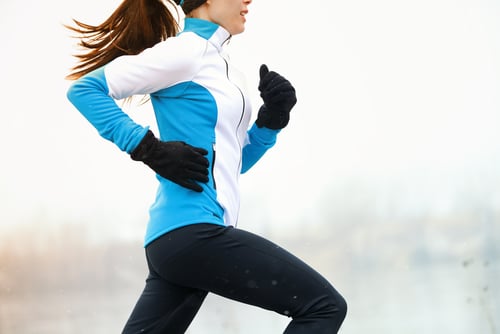 Neither rain nor snow nor sleet will keep some fitness enthusiasts from their daily outdoor exercise! While this level of dedication is admirable and can reap health benefits, even the fittest person can be susceptible to hypothermia, a dangerous and potentially deadly condition, when exercising in bad weather.
Neither rain nor snow nor sleet will keep some fitness enthusiasts from their daily outdoor exercise! While this level of dedication is admirable and can reap health benefits, even the fittest person can be susceptible to hypothermia, a dangerous and potentially deadly condition, when exercising in bad weather.
Our bodies function best within a fairly small range of internal temperature. If a person becomes chilled to the point where their body temperature drops below 95 degrees, the body loses the ability to produce enough internal heat to keep organs functioning normally. Symptoms of hypothermia include confusion, slowed reactions, loss of coordination, shivering, and drowsiness. Death usually occurs due to heart failure as the body’s core temperature falls too low for the heart to work properly. If a person already has a heart condition, this can occur relatively quickly, but even the healthiest person can fall victim to hypothermia.
Here are 7 important steps to take to avoid hypothermia:
1. Know Your Numbers
The actual air temperature is obviously an important consideration. But depending on conditions, hypothermia can occur at relatively mild temperatures, even above 50 degrees Fahrenheit! The most important number is the wind chill factor, which meteorologists usually say is “what it feels like outside.” But it “feels that way” to your body as well, and your body reacts to the perceived temperature. If the wind chill factor is significantly lower than the air temperature, dress as though the wind chill number was the “real” temperature.
2. Stay Dry
Above all else, avoid having soaked clothing next to your skin. Normally, even in snug fitting clothing, there is a thin layer of air trapped between your skin and the fabric. Your body heat warms this air and this is an important way that your body maintains its internal temperature. When clothing becomes soaked with water, it sticks to the skin and that layer of air is lost. If it is raining or snowing, have a waterproof outer layer of clothing and be aware when hats, gloves, or shoes are becoming soaked through. If you are already losing heat through your head and extremities, clothing closer to your body’s core is even more critical. If it becomes wet as well, hypothermia is a real danger.
3. Don’t Sweat It
If you tend to sweat heavily when exercising, even when it is cold out, you need to be extra vigilant. Sweat soaks clothing with moisture just as rain or snow does, and has the same effect on your body’s ability to warm itself. Consider a shorter exercise session or one that does not take you too far from home. For example, opt to run a 1-mile loop several times rather than several miles out and back. That way you can duck inside to warm up and perhaps even change into dry clothing.
4. Take a Break to Warm Up
Another possibility is to stop at a warm place mid-session or at your turnaround point. Run to a coffee shop, bookstore or library where you can spend a few minutes getting warm and perhaps duck into a restroom to change to a dry shirt before heading back. You could even work a nearby errand into your exercise session or arrange to stop by a friend’s house for a short visit.
5. Bring a Buddy
One reason hypothermia can be so deadly is that your mental clarity is one of the first things affected as your body draws heat from the head and limbs toward the center of the body. You may not realize that you are in danger until too late, and you are in serious or even life-threatening danger. People in advanced states of hypothermia will sometimes even shed their clothing because their confused brain believes they are too hot rather than too cold! If you exercise with a friend, both of you can watch for signs of confusion or clumsiness in each other and take steps to warm up before hypothermia progresses further. Take a fully charged cell phone with you when you set out (remember, cold causes batteries to drain more quickly!) and do not hesitate to call 911 if necessary. Keep an eye out for others around you who seem confused, uncoordinated, or are standing or sitting still, and call for assistance for them if you have concerns.
6. DON’T Just Move Faster
While it seems logical to warm up by running, walking briskly, or jumping around, this is actually very dangerous. As the body fights to keep the most important organs at the core of the body warm, it slows circulation to the limbs, which become colder still. Increasing the pace of exercise forces the blood into chilled extremities, causing further cooling of the body as a whole and damaging the ability to heat the crucial core organs.
7. Know When to Opt Out
Skipping one day of your fitness routine will not hurt you, but the consequences of pushing on with exercise in bad conditions can be devastating. Adjust your schedule for some indoor training–go to the gym, use home equipment like a treadmill or stationary bike. You can stay inside with an exercise DVD, some brisk cleaning, or even a play session with the kids. Or give yourself permission to stay warm and dry, and hope that, as the song says, the sun will come out tomorrow!
Related Articles By Cathe:
Workout Clothing: What Do You Wear When You Work Out and Does It Matter?
5 Surprising Myths and Facts about Sweating
Do Men and Women Sweat Differently During Exercise?

